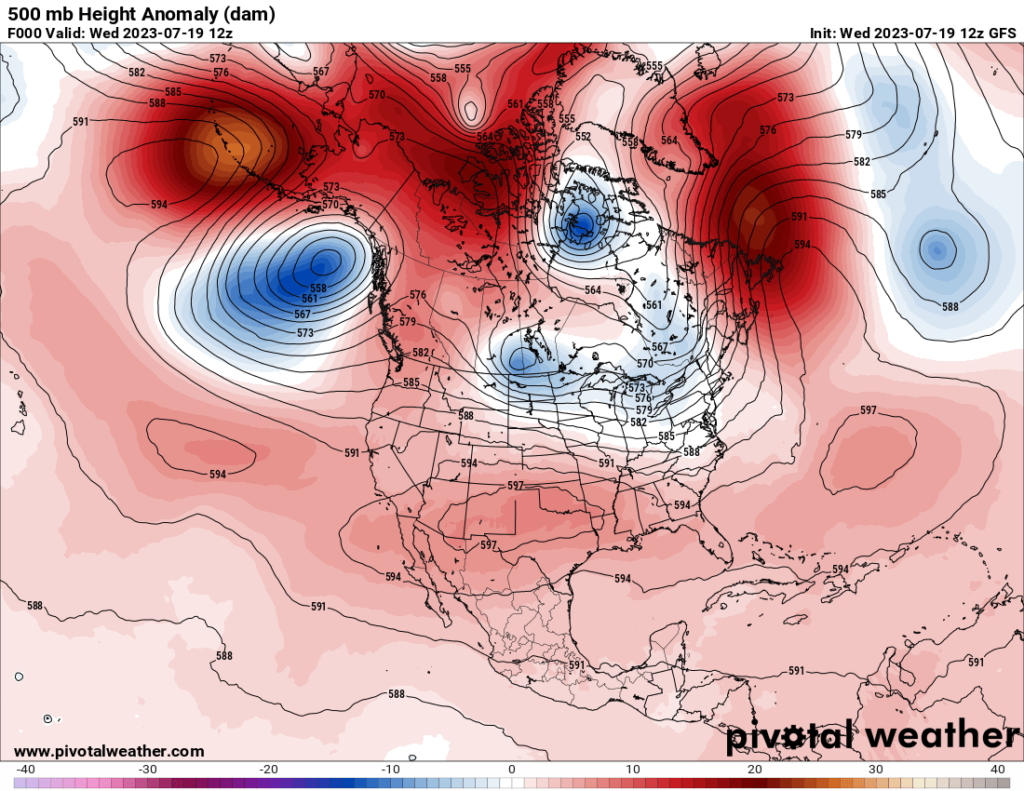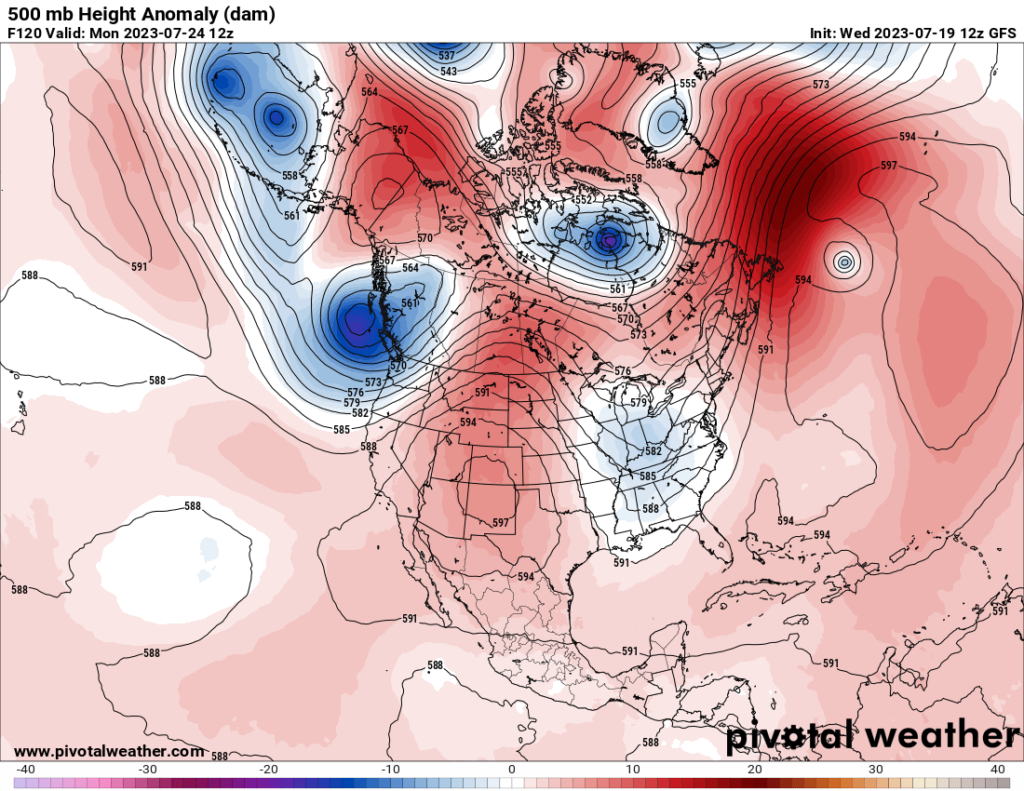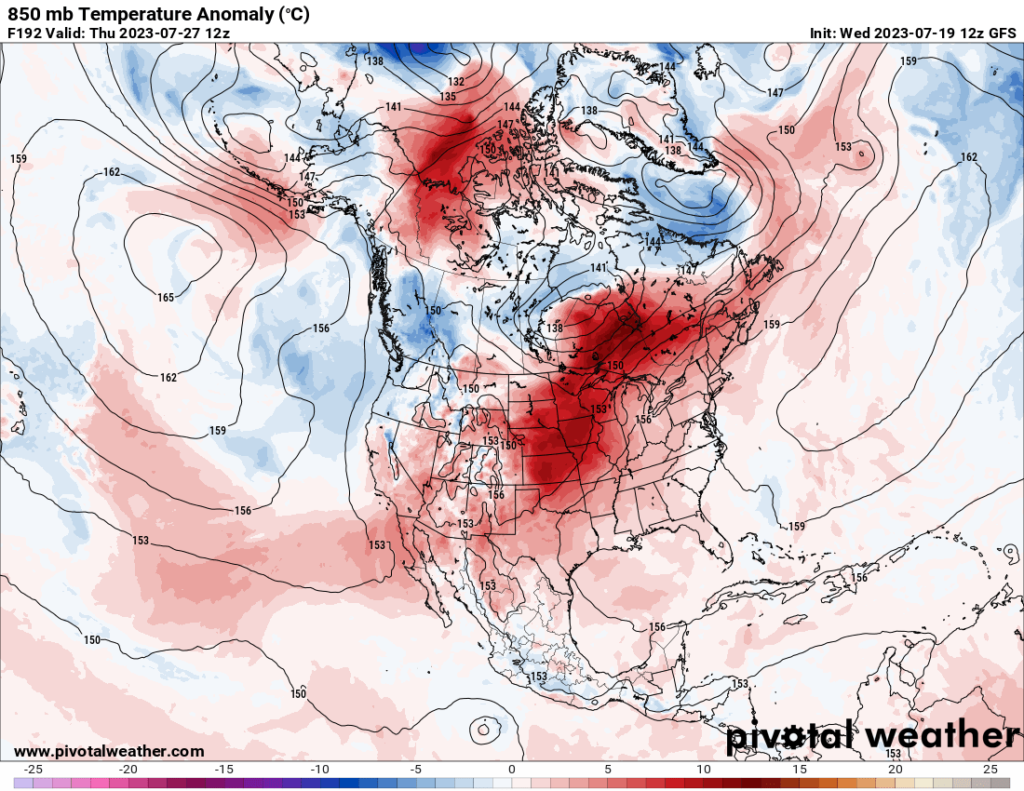The main purpose of this ongoing blog will be to track planetary extreme, or record temperatures related to climate change. Any reports I see of ETs will be listed below the main topic of the day. I’ll refer to extreme or record temperatures as ETs (not extraterrestrials).😉
Main Topic: The Longevity of Heatwave Chevron
Dear Diary. It’s time to take another look at historic CAT4 Heatwave Chevron. One reason why the thing is historic and likely to be blamed for more than 100 deaths is it’s persistence. We can follow the center of Heatwave Chevron’s upper-level best dome back to early July over the West:

On the above Pivotal Weather chart Heatwave Chevron started out under about a 592 decameter best dome over California when it became a major CAT3 using my criteria. Now it is a historic CAT4 extending all the way across the southern states from California into the Southeast:

As long as we can track an upper-level ridge in association with any major heatwave, it will exist using my rules. Thankfully, Heatwave Chevron will contract considerably by early next week, retrograding back to the West but remaining strong there:

In the longer term there are indications that the system will rebuild towards the north and east and could make life miserable for the Midwest, which is one of the few areas across the Northern Hemisphere that has seen below average temperatures this summer:


Now let’s take stock of Heatwave Chevron from my friend Matthew Cappucci writing for the Washington Post. Here is his latest report from 7/18/2023:
A brutal U.S. heat wave has surged for weeks. Here are 5 things to know. – The Washington Post
Five things to know about the brutal U.S. heat wave
More than 58 million Americans will face triple-digit temperatures this week

July 18, 2023 at 11:24 a.m. EDT

A look at high temperatures across the Lower 48 as forecast by the National Weather Service. (Pivotal Weather)
For more than three weeks, a blistering mass of brutally hot air has been baking the southern United States, toppling records from the Pacific to the Atlantic.
Some cities are facing a dangerous overlap of heat and oppressive humidity. Heat advisories or excessive heat warnings have been issued in 16 states, with the National Weather Service warning that “extreme heat and humidity will significantly increase the potential for heat related illnesses.” Actual air temperatures in the Desert Southwest will top 120 degrees in spots, while states along the Gulf Coast and Southeast face heat indexes of 110 or more.
76 million people in the U.S. may be exposed to dangerous heat today
Triggering the unrelenting heat is a “heat dome,” or a sprawling ridge of high pressure that’s bringing hot, sinking air. It has proved to be as stubborn as it is intense, refusing to budge as the Lower 48 deals with its impact for the fourth week in a row. While the heat has simmered back a few degrees in California, it’s building once again over the southern Plains, and shows no signs of going anywhere any time soon.
Here are five notable things about this heat.
It’s incredibly long-lasting

How bad is heat risk near you?
 (The Washington Post)
(The Washington Post)
We’re tracking dangerous heat waves across the United States daily. Look up your city to see extreme heat risks near you.
Heat domes are like any other high-pressure system; they may linger a few days, and then typically saunter eastward or break down as the overarching jet stream pattern changes. In this case, however, the heat dome has been a semi-permanent feature of North America’s weather pattern for weeks on end.
That has manifested in a number of records set, including in Phoenix, which just tied its longest-lasting streak at or above 110 degrees. Monday marked the 18th consecutive day to reach or exceed 110. That record will be broken Tuesday, when the high temperature is forecast to hit 117 degrees Tuesday and 118 on Wednesday and Thursday. In fact, weather models suggest that Phoenix could continue to tally 110 degree days nonstop for the remainder of the month.
In Texas, El Paso is entering Day 33 in a row with a high temperature at or above 100. That obliterates the previous record streak of 23 days, which happened during late June and early to mid-July in 1994. Records in El Paso date back to 1887.
All-time records tied

People walk along a trail as the sun sets on Sunday in Death Valley National Park in California. (John Locher/AP)
Across parts of Arizona and California, temperatures have even reached all-time records. California’s Death Valley was originally forecast to hit 130 degrees, tying the highest temperature reliably measured at the Furnace Creek Visitor Center in the past 90 years, but Sunday instead featured a high of 128 degrees.
Las Vegas made it to 116 on Sunday, one degree shy of its all time record. The city has hit 117 degrees on five occasions since bookkeeping began in 1937, four of which occurred in the past two decades. On Saturday and Sunday, Reno, Nev., set daily records, coming in at 106 and 108 degrees respectively; the latter also tied the city’s all-time record.
On Monday, Grand Junction, Colo., tied its all-time record of 107; bookkeeping dates back to 1893. Salt Lake City hit 106, also one degree short of tying the all-time record; the city tied the record twice last year. And Gallup, N.M., got to 101 degrees, tying an all-time record and establishing a new July record. Gallup sits at an elevation of 6,647 feet.
It’s more than just a dry heat
In the southwestern United States, the air is dry. That makes it easier to heat pockets of air to record levels. But in the southern Plains, the Deep South and the Southeast, a moisture-rich air mass is contributing to hazardous heat indexes. Heat index is a value used to estimate heat stress on the human body.
In Pauls Valley, Okla., there was a heat index of 126 degrees last Thursday, the highest ever observed in Oklahoma over the past 30 years.

Heat indexes as forecast by the National Weather Service for Tuesday. (WeatherBell)
On Tuesday, areas west of Interstate 35 in Texas and Oklahoma were predicted to see heat index values of 105 to 110 degrees, with values of 108 to 112 degrees more probable east of the highway. In Corpus Christi, Tex., the heat index is expected to reach up to 120 degrees Tuesday evening.
In Florida, it’s been a similar issue. The heat index in Miami has reached at least 100 degrees on a record 37 straight days. Fort Myers has posted its most 90-degree days on record year-to-date.
There’s also a marine heat wave going on

Sea surface temperature differences from normal surrounding Florida late Sunday. (WeatherBell)
The unrelenting sultry conditions in Florida are linked to bathtub-like warmth off its southwest coast. At Islamorada, where the seas are five feet deep, water temperatures of 94 to 96 degrees Fahrenheit were reported Monday. The hot oceans have been contributing to the extreme humidity in the air; Islamorada reported a heat index of 117 degrees.
On July 12, Garfield Bight, in the southwest corner of the Everglades in Miami-Dade County, reported a water temperature of 98.1 degrees. Granted, the water is shallow, but it’s still unheard of.
Experts fear the extreme water temperatures may help fuel powerful hurricanes, as well as contribute to coral bleaching.
The heat dome has quadruplets
The heat dome over the United States is not unique. In fact, there are three others globally that have each been setting records:
- In the Atlantic, a combination of factors has been overlapping to favor extreme warmth. Surface high pressure (the Bermuda High) was weaker than average in June, reducing easterly trade winds in the subtropics. That lead to less mixing of surface water that would have churned up slightly cooler waters from below. In turn, the sea surface heated up. Now, a heat dome is bringing hot, sinking air, warming the ocean further. Atlantic waters in the Northern Hemisphere are at their highest levels on record by far.
- In Europe, a heat dome is bringing temperatures 15 to 20 degrees above average. Rome could hit 108 on Tuesday, beating its all-time record of 105. Just last year, about 60,000 people died in Europe in multiple heat waves, according to a study published in Nature last week.
- And in Asia, a heat dome brought remarkable warmth to China. Sanbao, in far northwestern China, climbed to 126 degrees Sunday. That’s both a new national record (and surpasses the previous record by a wide margin) for China and a global record for any place north of 40 degrees North latitude.
While hot weather is a staple of the summertime and periodic extremes can and do happen, the effects of human-induced climate change on the atmosphere are playing a major role in pushing events into record territory.
More on extreme heat
Our warming climate: Here’s what to know about a sweltering heat wave that isn’t moving anytime soon. At Earth’s hottest spots, heat is testing the limits of human survival. It’s not just you — summers in the U.S. are getting hotter. Look up your city to see your extreme heat risk with our tracker. Take a look at what extreme heat does to the human body.
How to stay safe: It’s better to prepare for extreme heat before you’re in it. Here’s our guide to bracing for a heat wave, tips for staying cool even if you don’t have air conditioning, and what to know about animal safety during extreme heat. Traveling during a heat wave isn’t ideal, but here’s what to do if you are.
Understanding the science: Sprawling zones of high pressure called heat domes fuel heat waves. Here’s how they work. You can also read more about the link between weather disasters and climate change, and how leaders in the U.S. and Europe are responding to heat.

By Matthew Cappucci Matthew Cappucci is a meteorologist for Capital Weather Gang. He earned a B.A. in atmospheric sciences from Harvard University in 2019, and has contributed to The Washington Post since he was 18. He is an avid storm chaser and adventurer, and covers all types of weather, climate science, and astronomy. Twitter
Here are some other “ET’s” recorded from around the planet the last couple of days, their consequences, and some extreme temperature outlooks, as well as any extreme precipitation reports:
Here is more new June 2023 climatology:
Here is more climate and news from Wednesday:
(As usual, this will be a fluid post in which more information gets added during the day as it crosses my radar, crediting all who have put it on-line. Items will be archived on this site for posterity. In most instances click on the pictures of each tweet to see each article. The most noteworthy items will be listed first.)
2 thoughts on “Extreme Temperature Diary- Wednesday July 19th, 2023/Main Topic: The Longevity of Heatwave Chevron”